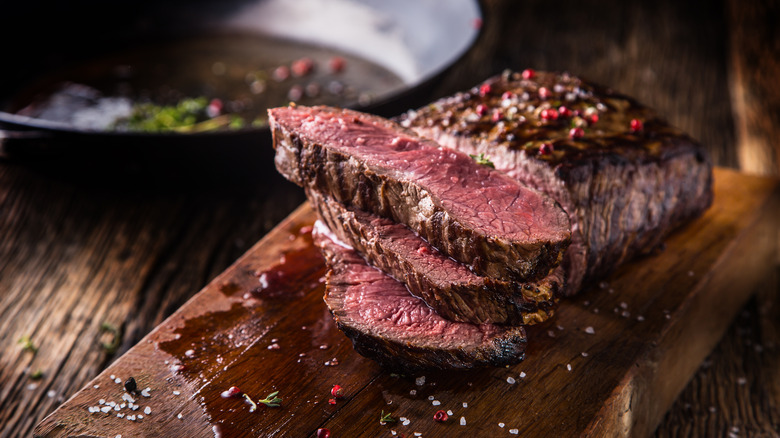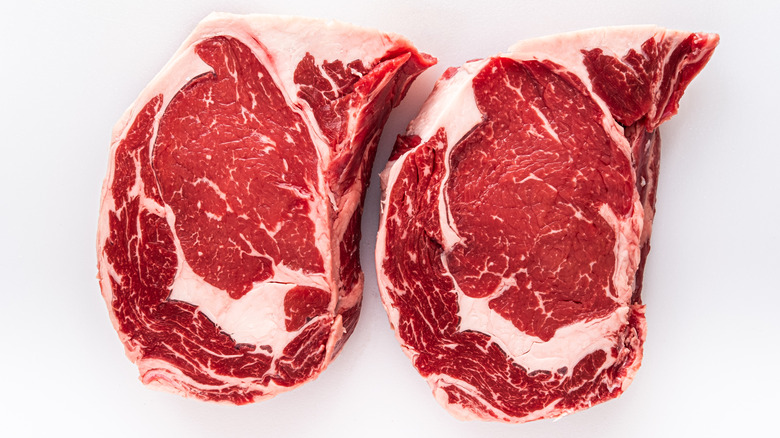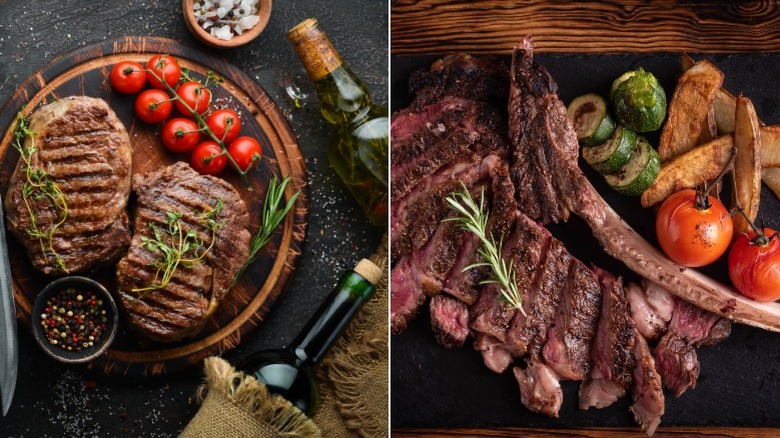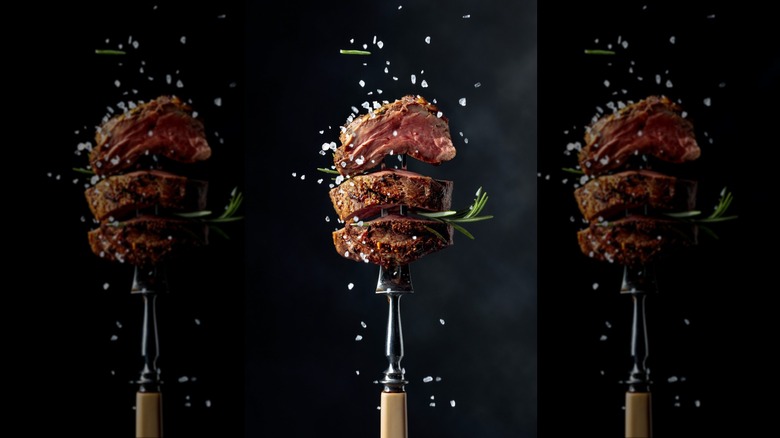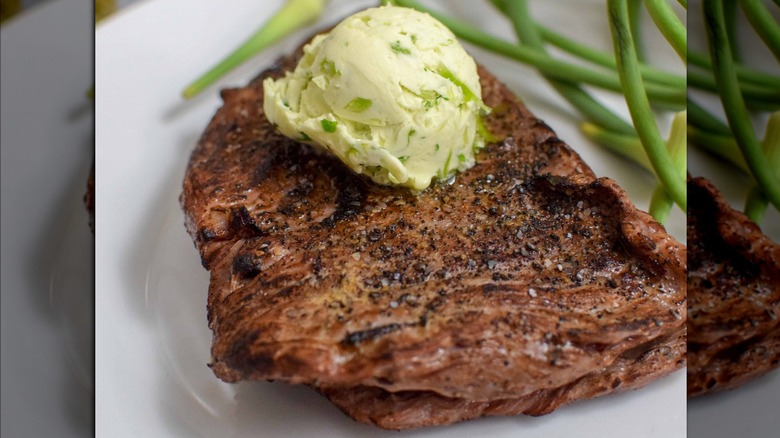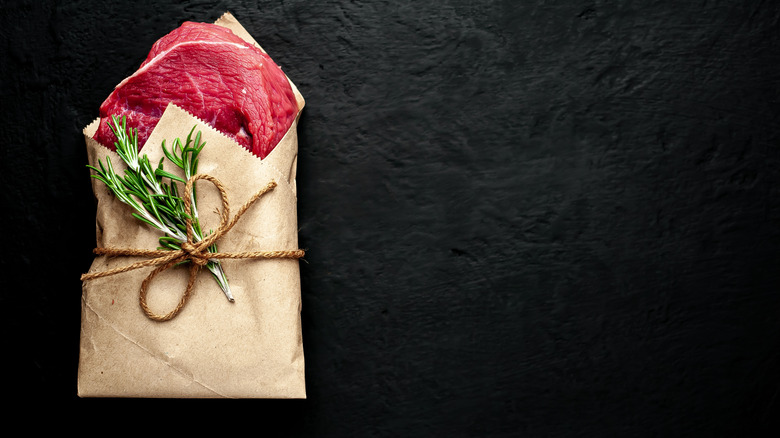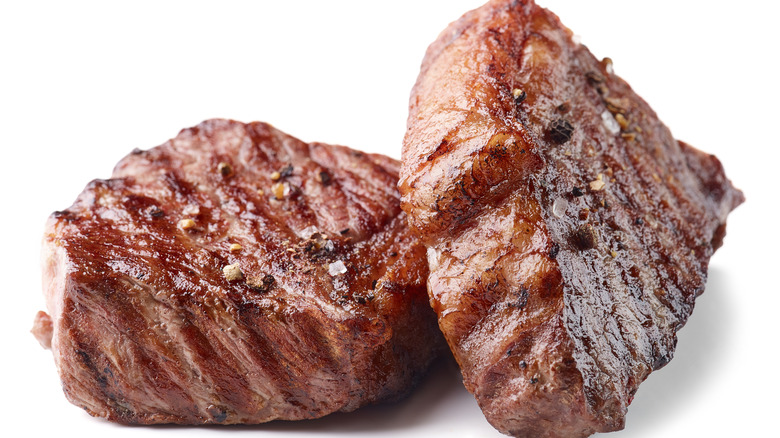What Is Delmonico Steak And Is It Better Than Ribeye?
The year 1837 was, by some accounts, a watershed year in American culinary history, as it marks the opening of what may have been the nation's first fine-dining establishment: Delmonico's in Manhattan. Amazingly enough, Delmonico's has stayed open for 184 years and counting — a feat that Untapped says makes it New York's fourth-oldest restaurant. And from the very beginning, Delmonico's has been known for one signature specialty: steak.
Any steak served at Delmonico's is, by default, a Delmonico's steak, and in the 19th century, "Delmonico's steak" was the term applied to the choicest hunk of cow being served up on any given evening. Over the years, however, the term evolved to describe a specific cut of steak that is served up at numerous other restaurants and can be purchased wherever fine beef products are sold. While there is still a bit of confusion regarding exactly what the official Delmonico cut might be, one thing is certain: any steak labeled Delmonico had better be top-shelf. Indeed, Grassland Beef notes that back in the day, the term "Delmonico" was often applied to anything perceived to be the best of its kind (kind of a 19th-century equivalent to "Gucci").
What is Delmonico steak?
It can be difficult to determine exactly what the term "Delmonico steak" entails. As Steak Perfection points out, the term has been applied to several different cuts of steak: a boneless chuck-eye, a bone-in rib steak, a bone-in ribeye, a boneless ribeye, a bone-in top loin steak, and a boneless top loin steak. In order to determine whether there is a "true" Delmonico steak, the outlet did a little more digging into the history of the term and its eponymous restaurant.
Cookbooks authored by two of Delmonico's legendary 19th-century chefs, Alessandro Filippini and Charles Ranhofer, both seem to indicate that the preferred cut for their signature steak would be a boneless top sirloin. But language and steak terminology changed over the centuries, and further research uncovered yet another possibility. What was once called "sirloin" is now known as "top loin," so it is likely that the steaks referred to by Filippini and Ranhofer were boneless top loin steaks cut from the front part of the short loin. Ranhofer also made mention of the thickness of the cut –- he said the steaks should be 2 inches thick but beaten until they are just 1 ½ inches high. Grassland Beef adds that Delmonico steaks should be wet-aged rather than dry-aged, and they say that their bone-in Delmonico steaks weigh around 14 ounces. Seven Sons, a butcher selling traditional boneless Delmonicos, says theirs weigh in at 12 ounces each.
Delmonico steak vs. ribeye
To go by the above definition, the main difference between a ribeye and a Delmonico steak would be the part of the cow from which each is cut. The ribeye comes from the rib section, while the Delmonico is cut from the short loin that lies back of the ribs but ahead of what we now call the sirloin area (via Tyner Pond Farm). While a true Delmonico steak should be boneless, a ribeye can be either bone-in or boneless, although The Spruce Eats points out that the former variety of ribeye may also go by the name of rib steaks.
Adding to the confusion between Delmonico and ribeye steaks is the fact that if you go to Delmonico's Manhattan restaurant and order one of its signature steaks, you will be served a thick-cut ribeye rather than a short loin steak (via Untapped).
What does Delmonico steak taste like?
As per Grassland Beef, a true Delmonico steak is known for being exceptionally tender and juicy. The meat has a very rich taste thanks to its being generously marbled with fat, which adds to the juiciness and flavor, per The Spruce Eats.
One specialty butcher, Alder Spring, profiles the Delmonico steak in its Meathacker blog. It reveals that you only get two Delmonico steaks per beef side, and they feel that these two steaks have slightly different flavor profiles. While they describe both Delmonicos as combining the robust flavor of the chuck steak with the tenderness typical of a ribeye, they say that the Delmonico that is cut closer to the ribeye is the tenderer of the two, and they've nicknamed it "The King." The other Delmonico is cut closer to the chuck and is a bit less tender, but they say it has more marbling and a slightly beefier flavor.
How to cook with Delmonico steak
If you want to go back to the earliest recipes penned by Delmonico's own chefs (via Steak Perfection), the steaks should be pounded, rubbed with oil or butter, sprinkled with salt and perhaps a bit of pepper, then charcoal-broiled for between 7 to 9 minutes per side (11 if you prefer your steak well-done). Bear in mind, though, that these cooking times may have been for slightly bigger steaks, as one recipe mentions them weighing about 20 ounces each after trimming. The steaks were to be served with clear gravy, Maître d'Hôtel, or Bordelaise sauce.
According to Untapped, today's Delmonico chefs cook their Delmonico (typically a boneless ribeye) steaks "black and red," meaning they are medium-rare inside but have a nice char on the outside. Grassland Beef, however, suggests broiling the steaks for about 3 ½ minutes per side after rubbing them with oil, salt, and any seasonings you prefer. They recommend letting the steaks rest for 5 minutes after cooking, then serving them brushed with the pan drippings and/or melted butter. You can also go old-school with compound butter.
Where to buy Delmonico steak
Delmonico steak can be purchased in most supermarkets, with the caveat that you won't really know what you're getting. The Spruce Eats warns that in many cases, you may just be getting chuck steak. But even if you go to a specialty butcher shop, you could be buying your steak from someone with a different definition of what constitutes a Delmonico. You'll probably have to ask to find out whether the Delmonico steaks on offer were (or were not) cut from the short loin.
If you're not really into firing off questions at people holding meat cleavers, or you don't have access to a number of high-end butchers in your area, you can always order your Delmonico steaks online. Most online butchers offering these — such as the previously mentioned Grassland Beef, Seven Sons, and Alder Spring — tend to explain on their websites exactly how and where they cut their Delmonico steaks. So even though you may need to pay a premium price to cover the cost of shipping a perishable item, you will have the satisfaction of knowing exactly what's on your plate.
Nutritional information about Delmonico steak
According to Nutrition Data, a steak cut from the short loin, trimmed to ⅛-inch of fat and broiled, has 518 calories for an entire steak and weighs 242 grams, or about 8 ounces. This is on the small side for a Delmonico steak, though, so with a 12-ounce serving, you'd be consuming about 760 calories. The 8-ounce steak also has about 37 grams of fat, so a 12-ounce piece would give you about 56 grams of fat. Unfortunately, nearly half of the fat is saturated, so that's one strike against this steak. As per Nutrition Data, a similarly-sized ribeye steak has just 420 calories for the 8-ounce serving and just 14 grams of fat (only 5 of them saturated), which speaks to it being a leaner cut.
On the positive side, both the Delmonico and ribeye steaks — like any cuts of beef — are entirely carb-free. What's more, they are very high in protein, providing most or all of the protein you need for an entire day. Both steaks are also rich in certain vitamins, particularly riboflavin, niacin, and vitamins B6 and B12. Mineral-wise, they're an excellent source of iron, magnesium, phosphorus, potassium, zinc, and selenium. Nutrition-wise, though, ribeye edges out Delmonico in the number of nutrients it provides due to having a higher meat-to-fat ratio.
